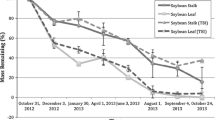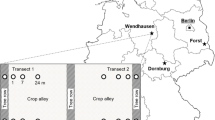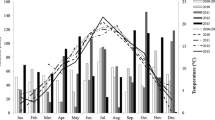Abstract
Short rotation coppice (SRC) is seen as a successful management system, which in addition to energy wood production may enhance soil carbon sequestration. The objective of this study was to investigate total, labile and stable soil carbon fractions at SRCs composed of poplar clones Max 1 (Populus nigra x P. maximowiczii), Muhle Larsen (Populus Trichocarpa), and black locust (Robinia pseudoacacia L.). Study was conducted at three SRC sites (Allendorf, Dornburg, and Forst) varying in age (1–4 years old), soil texture and climatic characteristics, in Germany. Composite soil samples collected at SRCs from 0 to 3; 0–10; 10–30; and 30–60 cm depth layers were compared with soils collected from adjacent crop strips. Samples were analysed for total organic carbon (TOC), hot-water extractable carbon (HWC), and organic carbon (OC) at 250–2,000; 53–250; and <53 µm soil-size aggregates. Total OC stocks in 0–60 cm soil layer were the highest at the site with the heaviest texture, Dornburg, followed by Forst and Allendorf, comprising 92–107; 59–74; and 53–64 Mg ha−1, respectively. Although no significant differences in the total OC stocks between SRCs and adjacent crops were found for the 0–60 cm layer, a significantly (p < 0.05) higher TOC, HWC, OC at macro-aggregates (250–2,000 µm), and the amount of macro-aggregates were found in the top 0–3 cm layer in all SRC sites (except the youngest poplar SRC in Forst) compared to adjacent crop strips. A greater macro-aggregate formation in SRCs related to the lower soil disturbance compared to the tilled crops, revealed a potential of SRC for C sequestration, as C occluded within soil aggregates has a slower decomposition rates and longer residence time.





Similar content being viewed by others
References
Baldock JA, Nelson PN (2000) Soil organic matter. In: Sumner ME (ed) Handbook of soil science. CRC Press LLC, Boca Raton, pp B25–71
Blake GR, Hartge KH (1986) Bulk density. In: Klute A (ed) Methods of soil analysis. Part 1. Physical and Mineralogical Methods, 2nd edn. American Society of Agronomy, Madison, WI, pp 363–375
Böhm C, Landgraf D, Makeschin F (2009) Changes in total and labile carbon and nitrogen contents in a sandy soil after the conversion of a succession fallow to cultivated land. Plant Nutr Soil Sci 173:46–54
Christensen BT (1992) Physical fractionation of soil and organic matter in primary particle size and density separates. Adv Soil Sci 20:1–90
DIN (2007) Bodenbeschaffenheit: Bestimmung des Carbonatgehaltes-Volumetrisches Verfahren (DIN-ISO 10693), Deutsches Institut für Normung e.V
Elliott ET (1986) Aggregate structure and carbon, nitrogen, and phosphorus in native and cultivated soils. Soil Sci Soc Am J 50:627–633
Gama-Rodrigues EF, Nair PKR, Nair VD, Gama-Rodrigues AC, Baligar VC, Machado RCR (2010) Carbon storage in soil size fractions under two cacao agroforestry systems in Bahia, Brazil. Env Manag 45:274–283
Ghani A, Dexter M, Perrott KW (2003) Hot-water extractable carbon in soils: a sensitive measurement for determining impacts of fertilisation, grazing and cultivation. Soil Biol Biochem 35:1231–1243
Haile SG, Nair PKR, Nair VD (2008) Carbon storage of different soil-size fractions in Florida silvopastoral systems. J Env Qual 27:1789–1797
Haile SG, Nair PKR, Nair VD (2010) Contribution of trees to soil carbon sequestration in silvopastoral systems of Florida. Glob Change Biol 16:427–438
Howlett DS, Mosquera-Losada MR, Nair PKR, Nair VD, Rigueiro-Rodriguez A (2011) Soil carbon storage in silvopastoral systems and a treeless pasture in Northwestern Spain. J Env Qual 40:1–8
Körschens M, Schulz E, Behm R (1990) Heißwasserlöslicher C and N im Boden als Kriterium für das N-Nachlieferungsvermögen. Zentralblatt für Mikrobiol 145:305–311
Lal R (2004) Soil carbon sequestration impacts on global climate change and food security. Science 304:1623–1627
Montagnini F, Nair PKR (2004) Carbon sequestration: an underexploited environmental benefit of agroforestry systems. Agrofor Syst 61–62:281–298
Mungai NW, Motavalli PP, Kremer RJ (2006) Soil organic carbon and nitrogen fractions in temperate alley cropping systems. Commun Soil Sci Plant Anal 37:977–992
Nair PKR, Kumar BM, Nair VD (2009) Agroforestry as a strategy for carbon sequestration. J Plant Nutr Soil Sci 172:10–23
Nair PKR, Nair VD, Kumar BM, Showalter JM (2010) Carbon sequestration in agroforestry systems. Adv Agron 108:237–307
Nii-Annang S, Grünewald H, Freese D, Hüttl RF, Dilly O (2009) Microbial activity, organic C accumulation and 13C abundance in soils under alley cropping systems after 9 years of recultivation of quaternary deposits. Biol Fertil Soils 45:531–538
Parton WJ, Schimel DS, Cole CV, Ojima DS (1987) Analysis of factors controlling soil organic matter levels in Great Plains grasslands. Soil Sci Soc Am J 51:1173–1179
Quinkenstein A, Böhm C, Matos E, Freese D, Hüttl RF (2011) Assessing the carbon sequestration in short rotation coppices of Robinia pseudoacacia L. on marginal sites in Northeast Germany. In: Kumar BM, Nair PKR (eds) Carbon sequestration potential of agroforestry systems—opportunities and challenges. Adv Agrofor, vol 8. Springer, New York, pp 201–216
Redei K, Osvath-Bujtas Z, Veperdi I (2008) Black locust (Robinia pseudoacacia L.) improvement in Hungary: a review. Acta Silv et Lignaria Hung 4:127–132
Schimel DS, Coleman DC, Horton KA (1985) Soil organic matter dynamics in paired rangeland and cropland toposequences in North Dakota. Geoderma 36:201–214
Six J, Elliott ET, Paustian K (2000) Soil macroaggregate turnover and microaggregate formation: a mechanism for C sequestration under no-tillage agriculture. Soil Biol Biochem 32:2099–2103
Six J, Conant RT, Paul EA, Paustian K (2002) Stabilisation mechanisms of soil organic matter: implications for C-saturation of soils. Plant Soil 241:155–176
Spain A (1990) Influence of environmental conditions and some soil chemical properties on the carbon and nitrogen contents of some Australian rainforest soils. Aust J Soil Res 28:825–839
SPSS (2012) Version 21, IBM corp
Acknowledgments
The authors thank the German Federal Ministry of Food, Agriculture and Consumer Protection (Project “AgroForstEnergie II”, project number: 22000312), the German Federal Ministry of Education and Research (Project “INKA BB”, project number: 01LR0803D) and the Vattenfall Europe New Energy Ltd. for the financial support. The authors also extend their grateful thanks to Manuela Bärwolff and Linda Jung, Thuringian State Research Centre for Agriculture (TLL), for the advices with regards to the study area; to the landowners of the study sites for allowing soil sampling, as well as to technical assistants Sebastian Heller, Katja Westphal, Nils Dietrich, and Norman Pittruff.
Author information
Authors and Affiliations
Corresponding author
Rights and permissions
About this article
Cite this article
Medinski, T.V., Freese, D., Böhm, C. et al. Soil carbon fractions in short rotation poplar and black locust coppices, Germany. Agroforest Syst 88, 505–515 (2014). https://doi.org/10.1007/s10457-014-9709-2
Received:
Accepted:
Published:
Issue Date:
DOI: https://doi.org/10.1007/s10457-014-9709-2




